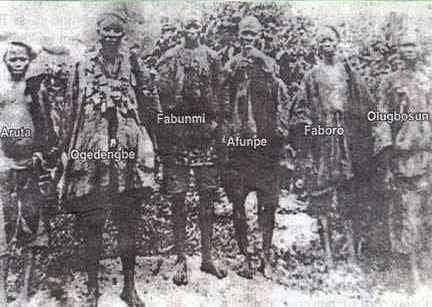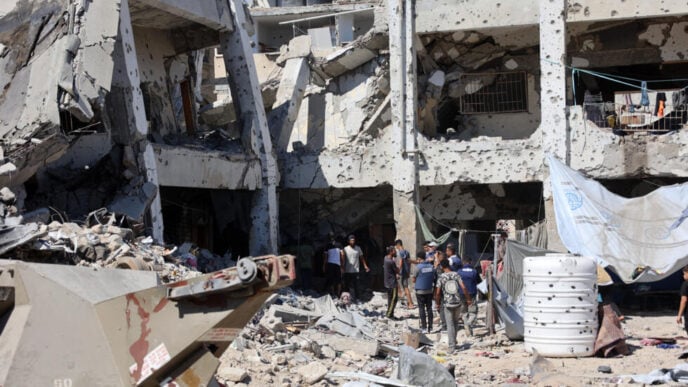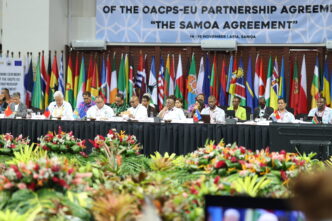It is now 138 years that the Yoruba civil war ended. No fewer than 400,000 soldiers participated in the war. Though often conceived as Ibadan/Ekiti Parapo war, in reality the war involved almost all Yoruba sub-ethnic groups. Prof Banji Akintoye in his book, ‘A History of the Yoruba’, estimated almost half a million soldiers that took part in the civil war.
A section of Ijebu, for instance, supplied arms to Ekiti allied forces while a section of Yoruba in today’s Togo and Benin Republic supported Ibadan. Yet, Yoruba in today’s Kogi State pitched tents. Akure, Ikale, Ilaje, Akoko-Edo and Itsekiri pitched their tents with Ekiti Parapo by offering tactical and strategic supports.
The war also had class content. Ibadan had become the most dominant military might in Sub-Sahara Africa, taking over territories and seizing swath of land. The Ibadan ruling class which emerged in the late 19th century had dominated and sought to dominate the Yoruba political economy to the envy and disdain of the working class and the masses who sought freedom and liberty. It’s class content was not in doubt: the rich, land owners against the masses, the armed against the defenceless, the military class against the business civilians, the haves against the have-nots. In this piece, I devote a short treatise to the military tactics of ancient Yoruba warriors who had created an infantry school at Ibadan and Otun Ekiti, w ballistic and research centre later surfaced at Okemesi; while Oyo maintained the headquarter for diplomatic affairs. Ile Ife retained her power as the spiritual spring. In 2011, I had the fortune on travelling across Yorubaland. I met offspring of great warriors. I met Latoosa and Ogedengbe in their sanctuaries. I had extensive and investigative collections, some of which I intend to share. One of the most interesting aspect of the 16-year old civil war is the military strategy and Tactics which, in my estimation, met the global standard of the time and would be useful to future military institutions if some of those tactics are not already in use.
The use of spies
Advertisement
In his book, The History of Yorubas, Rev Samuel Johnson reported the British sending ‘spies’ to the Yoruba battlefield.Both sides were legendary in the use of spies.
Ibadan was even more grandeur in its employment of beautiful women as spies. They were sent to Ekiti territories as traders during the war with focal points on communities with renowned military commanders like Oke-Imesi, Ado Ekiti, Ido-Faboro, Ire Ekiti and Irele Ekiti where Palaake was thought to be a high ranking military officer with spiritual authority, in the Ekiti Parapo Army. Some of these women allowed themselves to be captured and taken as wives. The term sex slaves only applied in Western lexicon. Captured women were legitimately married by the Ekiti generals. They had children and were treated as legal wives. Captain Caxton Banjo told me his great grandmother was one of the spies employed by Ibadan. She was captured and taken to Ire Ekiti where she raised children after she had married a certain officer of middle rank as relayed to Capt. Banjo by his late grandmother. The woman would visit the market places to meet other spies, posing as traders who would pass on military secrets to Ibadan. In my own community, and in several Ekiti villages remain significant Oyo population who after the war had assimilated into Ekiti culture. Their offspring still hold on to their tribal marks sustained over the years, from generation to generation. Ekiti Parapo soldiers were said to have employed hunters and dogs as spies. The hunters go into the bush with their headlamps at midnight with their trained dogs that spied on Ibadan positions. The hunters were trained to play neutrality claiming they were mere professionals. They also offered bush meat and palm wine to soldiers in their camps who sometimes carelessly released vital information to the hunters.
The study of animals
Advertisement
This may be similar to Hindus who believe animals have souls. Careful study of animals in war formation, mood of the enemy, weaponry, positions of the enemy was the science of war in the Yoruba primordial epoch. A particular mewing of the night birds sent messages about the enemy waking at dawn, from distant camps; the whistle of small birds at twilight, an indication that the enemy is coming slowly from far off, sudden racing of the Turupu, a clear indication that the on-coming enemy is fortified with weapons and a large army.
The seagulls taking flight and perching on the shore, an indication that the enemies were considering assault through the sea. Ibadan had a naval regiment which led to its victory in the Battle of Waterloo. Ekiti had to organise its own navy in a string of successful counter attacks. The fierce scramble of antelopes or leopards was an indication that the enemy was in trouble and may be retreating. When dogs bark non-stop at midnight, the enemy was considering a night raid and also an indication that ghosts of death were hanging which may actually meant the soldiers were about to lose a multitude of fighters. Sometimes, the dogs would cry like humans and even roll of the floor, I was told, a clear indication that the coming calamity would be difficult to overcome. A group of birds charging in spiral movement into the sky was a clear indication that the enemies were in disarray, probably fighting among themselves. When the birds surge in one direction, from one nearby tree to the other, an indication that the advancing enemy is weak. But when the birds take full flight into the unknown, a clear indication that the enemy was approaching with a fury of vengeance, usually when they had lost some of their soldiers. There was a particular way the squirrel would shriek that soldiers would know a big snake was amidst.
The study of dogs
Dogs are the oldest and most loyal friends of mankind. Dogs were designated as special guide angels on both sides. The lead soldier, usually of the rank of a captain, among the Ekiti Allied forces were expected to lash a dog. If the dog suddenly develops cold feet, flagging its tails, an indication that the battle would be lost and more people would die; if the dogs barked consistently, charging and forcing themselves to break loose from the guide, an indication that the battle would be bloody on both sides with heavy casualties, if the dogs wag their tails endlessly and playfully, an indication that the soldiers would crush the enemies decisively.
Advertisement
Pigeons as pathfinders
Before going to battle, the soldiers gather a dozen pigeons. Each is released into the sky one after the order. A tough battle would see the pigeons reluctant and cold while an easy-to-win battle would see the pigeons fly one after the other into the unknown space. When the pigeons fly and perch on nearby trees, an indication that the commander of the battle would be killed but then the pigeons perch right on the floor, an indication that many of the enemy soldiers would be buried. When the pigeons refuse to fly even when prodded, an indication that it was better the soldiers take flight from battle.
Strength and weakness of the enemy
When the enemy begins to retreat swiftly, it indicated fear, when retreat is in orderly column, the enemy is setting a bait, when retreat followed continuous fight back from the enemy, it indicated the enemy is starved of weapons. When a fighting force struggles to pick the remains of the wounded and the dead, it showed discipline at its highest pick, when they are abandoned, it showed disarray among the fighting force and possibly a brewing internal rebellion.
Advertisement
When a force attack a small town with overwhelming force, it indicated weakness, when the town is taken with a small force, it indicated order and strength. When a force offers to surrender without conditions, it is a plot, when the force chose surrender with conditions, it could be a plot and at the same time show of real strength.
In peace meetings, delegates should take not of the movement the eyes of the rank and file, and that of the Generals should be well studied. The movement of the black circle speaks in volumes: When the eyelids blink frequently, the enemy is exhausted and frightened, when the blink is occasional, the enemy radiates with prowess. A force that kills its own rank and file for indiscipline should be provoked to ceaseless battles, for its hot temperament which would eventually lead to its fall on the battlefield.
Advertisement
The place of plants in making war plans
Watching the response of plants and trees to the prevailing wind could send strong signals to intelligent Yoruba primordial Army that also ran an Intelligence Corps. When roses suddenly bloom at dawn, the battle would be success, when they recoil, even as the sun rose, danger was ahead. When elephant grasses are downcast, an indication that the enemies had only recently passed through the same spot; when the grasses are solemn, an indication that the enemies had not being through the pathway. One old man in his 90s at Itapaji Ekiti told me that Iroko trees were believed to possess some powers and usually appeased by the soldiers before going to war. When the Iroko tree is still, the battle would be lost; when it is radiant, dancing to the wind, the prospect of victory is high; when the dance is occasional, punctuated by sudden dances of the thick and light stem, the battle would be undecided for both parties. Trees were also used as listening (day) and watching posts (night). But both sides employed decoy to deceive the enemy. The tactics of both parties were dynamic as each saw rise and fall in fortunes during the 16-year war.
Advertisement
Ibadan also ran an infantry school while Oke Mesi was hot bet of ballistic experts who manufactured local explosives.
Both sides taught weapon handling, ambush, guerrilla warfare, attack, retreat and encampment while discipline was the hallmark. Generals on both sides earned respect and when one was captured, the rank and file must not look at his eyes.
Advertisement
It is unfortunate that the full history and the majesty of the Kiriji war is yet to be fully documented. Africans must learn to tell their own history and our own civilisation portrayed to the world.
I worked hard to have the South West States establish a Yoruba Museum of War History. We began with the stage performance of Kiriji in Ekiti State which drew the likes of Dele Odule, Kanran, Oodua and great Nollywood artistes to Ekiti in a 3-day all night performance that saw the halls filled to the brim. The current Latoosa, Fabunmi of Okemesi and Ogedengbe of Ilesa also attended with their retinue to aides and traditional warriors. The play was directed by one of Africa’s greatest Artiste, Mr Abiodun Abe who succeeded late Herbert Ogunde as leader of the Nigerian National Troupe.
The former Governors of Ekiti and Osun, Dr Kayode Fayemi and Ogbeni Rauf Aregbesola were enthusiastic about the project.
They even made contacts with their contemporaries. Other state governors at that time were reluctant which stunted the project. It is never too late. I still nurse the idea of a Yoruba Museum of War history, which in itself, should generate revenue and enhance the pride of Yoruba civilisation. In mid-1990s, I was in The Guardian Newspapers. A group of hunters discovered a large cache of weapons captured by the Yoruba Army during the Fulani invasion of Osogbo and their humiliating defeat. The first thing was that the Federal Government ordered that the ancient weapons be transferred immediately to Sokoto. Imagine. Whereas, the same Federal Government had carted away weapons of war used by Ogedengbe and Latoosa. The weapons were transferred to what they called the Nigerian National Museum. I believe the British Museum is also repository of several ancient weapons seized from Yoruba territories during the Kiriji War. No doubt, there is universality in military tactics of great nations.
Little wonder that some of the recollections, from generations, are similar to the Chinese tactics of war in the ancient times as recorded by Sun Tzu. In my opinion, the use of animate and inanimate elements in war formations by Yoruba ancient warriors is far deeper than that of the Chinese.
Adeoye, a CNN Award winning journalist, writes from Lagos.
Views expressed by contributors are strictly personal and not of TheCable.
Add a comment











